Abstract
The purpose of analyzing the dissolved gas in transformer oil is to determine the transformer’s operating status and is an important basis for fault diagnosis. Accurate prediction of the concentration of dissolved gas in oil can provide an important reference for the evaluation of the state of the transformer. A combined predicting model is proposed based on kernel principal component analysis (KPCA) and a generalized regression neural network (GRNN) using an improved fruit fly optimization algorithm (FFOA) to select the smooth factor. Firstly, based on the idea of using the dissolved gas ratio of oil to diagnose the transformer fault, gas concentration ratios are also used as characteristic parameters. Secondly, the main parameters are selected from the feature parameters using the KPCA method, and the GRNN is then used to predict the gas concentration in the transformer oil. In the training process of the network, the FFOA is used to select the smooth factor of the neural network. Through a concrete example, it is shown that the method proposed in this paper has better data fitting ability and more accurate prediction ability compared with the support vector machine (SVM) and gray model (GM) methods.
1. Introduction
Transformers are an important component of a power system. Its running state can directly affect the reliability of the entire power supply and system stability. Through an analysis of the dissolved gas in the oil, we can obtain the operation status of the transformer to determine the type of failure and can timely detect the potential risk of transformer operation failure [1,2,3,4]. It is important to study the prediction of dissolved gas concentration in oil, and its prediction results can provide a reference value for transformer state evaluation.
As the concentration of dissolved gas in transformer oil has always been in a state of dynamic change, a major focus in the prediction of dissolved gas concentration is to find a prediction method with strong adaptability and takes the impact of various factors into consideration. Over the past few decades, many data analysis methods have been proposed to solve this problem, including gray model (GM) [5,6,7], support vector machine (SVM) [8], and artificial neural network (ANN) [9]. The authors of [10] used a kind of GM that takes into account only the development status of the gas, which had a general prediction effect. According to the results of thermodynamic study of the decomposition of insulating oil, there are connections between the gas components produced by the cracking reaction. For example, when the insulating oil is overheated, methane and ethylene are the major gas components and have a strong correlation. The prediction result of the GM is related to the law of the data itself. When the data has a definite trend, the prediction effect is better. Otherwise, the prediction effect is poor. The authors of [11] overcame the requirement of GM for data distribution by using SVM, which uses the structural risk minimization method to improve generalization and it is not easy to achieve over-fitting for SVM. However, when applied to the regression estimation problem, the performance of SVM is affected by the input vectors. The data, which contains large numbers but ultimately consists in a small amount of information, may obscure the data containing small numbers but consisting in a large amount of information. The authors of [12] proposed a deep belief network (DBN) approach to predict transformer concentrations. They achieved good prediction accuracy, but their method ignores the relationship between the individual gas components.
In general, there are mainly two problems with the current method like GM, SVM and ANN. First, it is relatively simple to use only the concentration of each gas in the oil as the input vector, but the numeric size and amount of information contained in the input data can affect final prediction accuracy. Secondly, the accuracy of predictions of gas concentration in oil needs to be improved. In view of these two problems, this paper proposes the KPCA-FFOA-GRNN model to predict the gas concentration in transformer oil.
- (1)
- The PCA method is widely used to reduce dimension. Based on PCA, kernel principal component analysis (KPCA) firstly maps the original data to a high-dimensional linear feature space via kernel function and then uses the PCA method to extract features. The KPCA algorithm has a wide range of applications in the fields of feature extraction, data compression, and pattern recognition [13,14,15]. In order to solve the problem of transformer fault diagnosis, the authors of [16] obtained 34 eigenvectors by combining electrical experiment data with dissolved gases in oil and uses the KPCA method to reduce dimensions. In [17], a method is proposed for real-time fault diagnosis of high-voltage circuit breakers using KPCA and SVM. An adaptive KPCA is proposed to analyze the similarity between samples, and the redundant data can be eliminated. In this paper, we mainly use KPCA to extract the main parameters from the original input vector, which plays the role of simplifying the complexity of the input vector while preserving the main information of the input. In addition to the original gas concentration, the ratios of various gas concentrations are used as reference vectors. We then use the KPCA method to select the main parameters as the training input of the neural network.
- (2)
- As a radial basis function neural network, the generalized regression neural network (GRNN) has good nonlinear function fitting ability. The training parameters are simple and the convergence speed is fast. It is widely used in the fields of prediction and pattern recognition [18,19]. The authors of [20] proposed a modified GRNN and a procedure to automatically reduce the number of inputs of the artificial neural networks to forecast the global load and the local load, and high prediction accuracy was achieved. In this paper, the generalized neural network is used to predict the dissolved gas concentration in the transformer oil. The improved fly-optimization algorithm is used to optimize the training parameters in the network.
- (3)
- In the GRNN network training process, the value of the smoothing factor σ has a great influence on the prediction accuracy of the model. It is clear that the accuracy of the model cannot be guaranteed by the experience setting alone. In [21], fuzzy clustering and particle swarm optimization (PSO) algorithms are used to optimize the parameters. In [22], the firefly optimization algorithm (FOA) is used to select the parameters. In [23], a better prediction result of distributed power generation is obtained using the SVM model with FOA optimization parameters. In this paper, we use the improved fruit fly optimization algorithm (FFOA) to automatically select the most appropriate smoothing factor. Compared with the previous few parameter optimization algorithms, the accuracy is guaranteed, and the program is simpler and easier to understand.
This paper thus presents a combined predicting model based on KPCA and an optimization of GRNN. Based on the idea of using the dissolved gas ratio in the oil to diagnose the transformer failure, the ratios of the gas concentration are also used as the reference vector besides the original gas concentration. The KPCA method is then used to select the main parameters as inputs to train the GRNN network. In the construction of the network, the FFOA is used to select the smoothing factor of the network. We not only make full use of the input vector and take into account the correlation between variables, but we also simplify the complexity of the calculation and minimize the human intervention process. The experimental results show that the method proposed in this paper has high prediction accuracy.
2. Related Theory
2.1. KPCA
PCA is a linear reduction of the data compression method. Main components can be extracted from high-dimensional variables. Although the dimension and complexity of data are reduced, the extracted data can only characterize the linear state of the device. The extracted data lose the nonlinear components in the original data and lacks the valid information. The principle of KPCA is based on PCA. First, the original data is mapped to a high-dimensional linear feature space by the kernel function to complete the nonlinear variation. The PCA method is also used to extract the feature. The essence of KPCA is to perform the PCA of the data mapped into the feature space.
Let the original data be x = {xij}m × n, and its dimension m. xi represents the ith sample. The x is mapped onto the feature space F through the non-linear mapping f, and the original image xi has the feature of f(xk) on the feature space. Assuming that the mean of the mapped data f(xi) is zero, the sample covariance matrix on the high-dimensional feature space F is:
Let v be the eigenvector corresponding to the eigenvalue λ of Cov in Equation (1):
Let both sides of Equation (2) be the inner product of f(xk):
Since the eigenvector v can be linearly represented by the data set f(xi), let αi be the coefficient; thus:
Taking Equations (1) and (4) into Equation (3):
Define the kernel variance matrix K of the m × m dimension, and its expression is:
In order to ensure the input data f(xi) satisfy zero-mean conditions, K needs to be corrected. The modified kernel function is:
where Im is a matrix of m-order values of 1. After calculating eigenvalues λi and eigenvectors pi, the eigenvalues are sorted and the corresponding eigenvectors are also adjusted accordingly. Then, the cumulative contribution rate Ti of the feature value is calculated. According to the set threshold, if Tk ≥ ε, choose k sequences as the main element. The equation of cumulative contribution rate Tk is:
2.2. FFOA
The FFOA is an optimization algorithm proposed by a Taiwan scholar, Wen-Tsao Pan. The algorithm simulates the foraging behavior of fruit flies: firstly, finding the general orientation of objects with the sense of smell and then visually finding the specific location of objects and approaching to forage at close range.
The traditional FFOA has several shortcomings. First, when initializing the position of the individual fruit fly in the population, the equation is given by Equations (9) and (10):
where Init_X are Init_Y are a randomly initialized fruit fly population position. The steps of traditional method are fixed. If the step size is set too large, the searching ability of the algorithm will be weakened and the searching time will be too long, resulting in the low efficiency of the algorithm. If the setting step is too small, the algorithm may fall into the local optimum. Secondly, the traditional FFOA has the problem of low convergence accuracy.
In response to the first problem, this paper improves the selection of the step value and adopts the dynamic step instead of the fixed step. The optimized step length equation is as follows:
where ki is the current number of iterations, k is the maximum number of iterations, and l0 is the initial step. For the second problem, this paper draws on the cross-validation method, and the population is divided into multiple equal sub-populations. The analysis is optimized, and a global optimal solution is finally selected. The scheme ensures that the algorithm can make full use of the data to prevent the algorithm from falling into the local optimal solution.
2.3. GRNN
The GRNN is a new type of neural network proposed by American scholar Donld F. Specht. It is a radial basis neural network based on nonlinear regression analysis. The network has the ability to predict any form of function from historical data and finally converges to the optimal regression with the largest sample size accumulation. It is similar to multi-layer perceptive neural network in structure. It consists of an input layer, a pattern layer, a sum layer, and an output layer. Its network structure is shown in Figure 1.
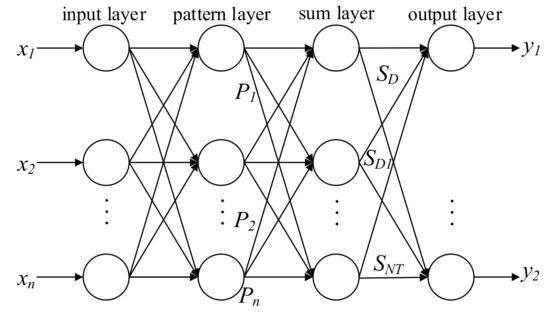
Figure 1.
Structure of the generalized regression neural network (GRNN).
Let f(x,y) be the probability density function of the random variables x and y. Let x be the input vector of p dimension, and y be the corresponding output vector. X is a set of measured values of random variable x, so the regression value of y relative to X is:
is also the predicted output y, corresponding to the input X. When the probability density function f(X,y) is unknown, we need to use the Parzen nonparametric estimation method to estimate the density function using the collected sample data {xi,yi}:
where , , n is the capacity of the sample; σ is the width factor of the Gaussian function, also called the smoothing factor or the extended parameter.
Using the in Equation (13) to replace in Equation (12) and , we can get:
It can be seen from Equation (14) that the estimated value is the weighted average of all sample observations yi, and the weighting factor of each observed yi is the exponential of the Euclidean distance between its corresponding samples xi and X. It is very important to predict the parameter σ when constructing the GRNN network. When the smoothing factor σ tends to infinity, d(X,xi) tends to zero, which represents the mean of all sample dependent variables. When the smoothing factor σ tends to zero, it is very close to the training sample. At this point, if the predicted point is in the training sample set, the predicted value will be close to the expected value of the sample; however, once the new data, i.e., the sample, cannot be included in the point, the prediction effect may be very poor, unable to meet predicting requirements. Therefore, only when the smoothing factor σ is appropriate can the dependent variable of all training samples be taken into account. In this paper, we use the FFOA to select the smoothing factor σ. The results show that the proposed method has better global convergence and improves the accuracy and reliability of the prediction process.
3. The KPCA-FFOA-GRNN Prediction Model
When a transformer works in normal operation, its internal insulating oil and solid insulating material due to electric field, humidity, and oxidation will produce a small amount of gas that includes hydrogen (H2), carbon monoxide (CO), carbon dioxide (CO2), methane (CH4), acetylene (C2H2), ethylene (C2H4), and ethane (C2H6). When the transformer fails or has abnormalities, some of the gas components will change. For example, when thermal failure occurs, the resulting gas is mainly CH4 and C2H4, and the two have a strong correlation. When the electrical fault occurs, it will produce more C2H2 and H2, and the two have a strong correlation. Therefore, in the transformer fault diagnosis analysis, the relationship between each gas concentration needs to be considered. The current common method is to use the IEC ratio (CH4/H2, C2H2/C2H4, C2H4/C2H6), the Rogers ratio (CH4/H2, C2H2/C2H4, C2H4/C2H6, C2H6/CH4), the Dornenburg ratio (CH4/H2, C2H2/C2H4, C2H2/CH4, C2H6/C2H2), and the Duval ratio (CH4/C, C2H2/C, C2H4/C, where C = CH4 + C2H2 + C2H4). This article draws on the idea of using the dissolved gas analysis (DGA) ratio to diagnose transformer faults. Taking the ratio of any two of seven kinds of gas concentrations and the Duval ratio as a reference, this paper makes up a 31-dimensional reference vector together with the original seven kinds of gas concentrations. The transformer oil dissolved gas concentration prediction model based on KPCA-FFOA-GRNN is shown in Figure 2.
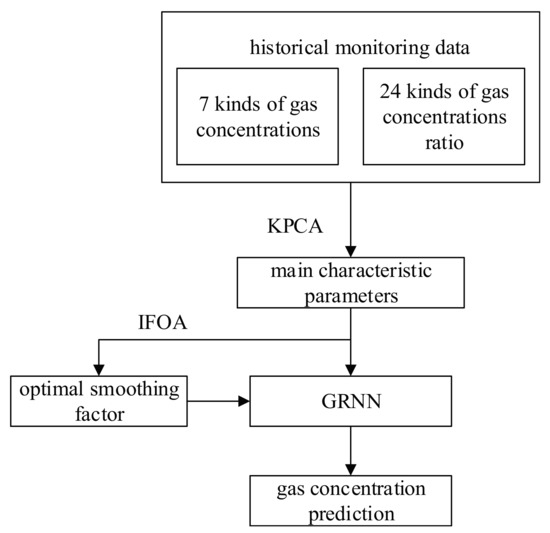
Figure 2.
Flow chart of transformer oil dissolved gas concentration prediction.
Step 1: Obtain the historical monitoring data of 31-dimensional reference vectors to get the historical change of each state quantity.
Step 2: Use the KPCA method to extract the main eigenvectors from the 31-dimensional reference vectors. The input vector of the GRNN neural network is composed of a reference vector set with a cumulative contribution rate of more than 90% and a gas concentration vector to be predicted.
Step 3: Optimize the model parameters by using the FFOA to select the most appropriate smoothing factor σ and train the GRNN neural network.
Step 4: Use the trained neural network to predict the dissolved gas concentration in transformer oil.
In order to evaluate the accuracy and validity of the proposed prediction model, the following evaluation criteria are used to analyze. The root mean square error Rmse of the predicted value and the true value of the test set is determined as follows:
The relative percentage error between the true value and the predicted value is determined as follows:
The maximum value of relative percentage error is determined as follows:
where N is the number of test set data. xi is the true value, and is the predicted value.
4. Case Studies
4.1. Prediction of Dissolved Gases Concentration
Oil chromatographic data sets from an online monitoring device in a 220 kV substation were used in our experiments. The substation was installed in Shandong Province, China, and connected with a dozen transmission lines. An oil chromatography device was used to measure the data of the high-voltage side. This substation has been put into operation for over 10 years. One short-circuit accident has occurred, but the substation was not overhauled. The data sets are daily observations of dissolved gases in the transformer insulation oil from over three years from October 2010 to May 2012. The 700 sets of monitoring data were used as training samples.
We use ethylene gas concentration prediction results as an example here to illustrate the entire predicting process. The KPCA method is used to make principal component analysis of 31 reference vectors and extract 8 sets of vectors (H2, C2H2, C2H6, CO, C2H4/C2H6, C2H6/CH4, C2H2/C2H4, CH4/H2) and then together with the original ethylene gas concentration sequence as the input vector of the neural network. In the process of neural network training, we use the FFOA to get the smoothing factor σ. The value of Rmse during the training process is shown in Figure 3. After 100 iterations, it finally converges in the 44th iteration. In this case, the minimum Rmse value is 0.0105, and the corresponding smoothing factor σ is 0.0867. The value of the smoothing factor is brought into the neural network to predict the concentration of ethylene gas, and the prediction result is shown in Figure 4.
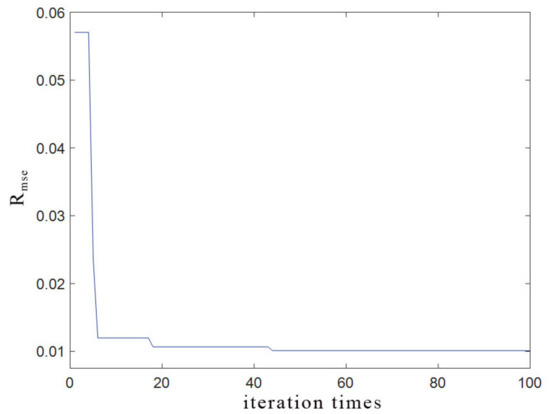
Figure 3.
Fruit fly optimization algorithm (FFOA) optimization process.
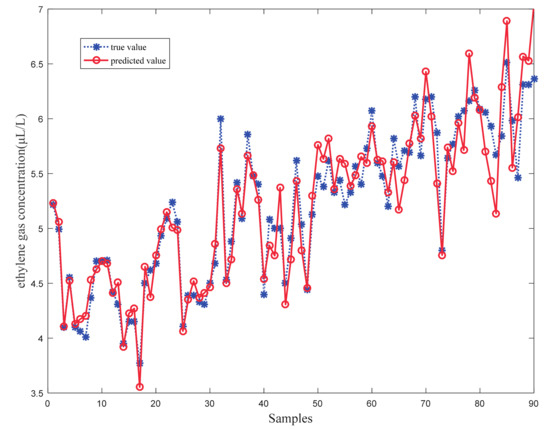
Figure 4.
Ethylene gas concentration prediction results.
As shown in Figure 4, the combined prediction model presented in this paper has better fitting ability and predictive ability, and has a good degree of fit to the trend of ethylene gas concentration. The relative percentage error between the true value and the predicted value is shown in Figure 5, in which the average relative percentage error is 3.27% and the maximum relative percentage error is 11.34%.
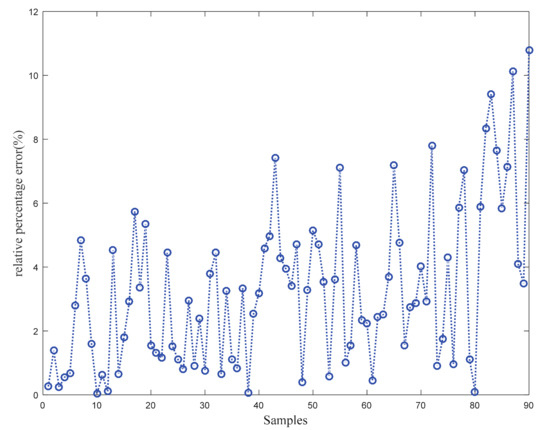
Figure 5.
Relative percentage error of ethylene gas concentration prediction results.
Similarly, taking the oil chromatographic sample data taken from 2 October 2010 to 13 May 2012 as an example, we used the model in this paper to predict the concentrations of other gases. The number of training set samples is 700, and the number of predicting samples is 30. The prediction results are shown in Table 1.

Table 1.
Other gases concentration prediction error (%).
The prediction method in this paper was compared with the FFOA-GRNN, KPCA-GRNN, GRNN, back propagation neural network (BPNN), SVM, and GM prediction methods. The predicted eigenvector is the ethylene gas concentration, and the number of samples in the test set is 30. The predicted results are shown in Table 2. As can be seen from Table 2, prediction accuracy will be reduced if we do not use the KPCA method to extract the main parameters from the input. This is because the size of the value and the amount of information contained in the data will affect the final results. We need the KPCA method to extract the main parameters from the input. The prediction accuracy of the KPCA-GRNN model and the GRNN model without using the FFOA is lower, which indicates that the FFOA method can optimize the parameters and improve the prediction accuracy. Compared with the other methods, the prediction model proposed in this paper is more accurate in the case of the same number of samples in the test set, and the fitting ability of the data is much better.

Table 2.
Prediction error for different prediction method (%).
Different predicting scales will also have an impact on the accuracy of prediction. We separately predicted 10, 30, and 90 data points. The prediction results are shown in Table 3. From Table 3, it can be concluded that, when the prediction scale is small, the prediction model proposed in this paper is more accurate than the other models. As the number of test sets increases, the prediction scale becomes larger and the prediction accuracy of these models decreases. However, the proposed prediction method is obviously superior to the other two models in terms of prediction performance.

Table 3.
Prediction error for different amount of test set (%).
We used the KPCA-FFOA-GRNN method to test 23 other transformers at the same voltage level. The prediction error of the results is shown in the Table 4. The prediction error in the first 30 points of 15/23 transformers is below 5%, which shows that the method proposed in this paper has high accuracy.

Table 4.
Test results of other transformers (%).
4.2. Application in Pre-Emergency State of Transformer
For large-scale power transformers, almost all devices currently use oil-impregnated paper insulation structure, with insulating oil for insulation and heat dissipation. With the operation of the transformer, the solid insulating material in the transformer and oil gradually ages and decomposes under the action of electricity and heat. Generally, for different types of faults, the characteristics of dissolved gas and the proportion of various gases are not the same. Therefore, the composition and content of the dissolved gas in the oil to some extent can reflect the aging of the power transformer insulation and the degree of abnormality. According to transformer oil dissolved gas analysis and judgment guidelines in China, when the gas content in the transformer oil exceeds the values listed in Table 5, the technical maintenance staff need to immediately check the operating status of the transformer.

Table 5.
Attention values of dissolved gas content in power transformers.
This section analyzes the chromatographic monitoring data collected by a transformer in a fault condition. The KPCA-FFOA-GRNN method proposed in this paper was used to predict the hydrogen sequence in oil chromatography. The predicted results are shown in Figure 6.

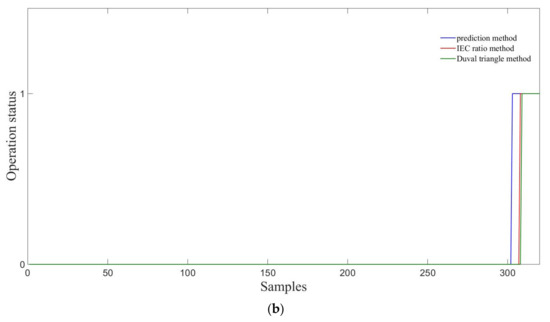
Figure 6.
Application in pre-emergency state of the transformer: (a) hydrogen gas concentration prediction results (b) transformer operation status.
In Figure 6a, the blue line shows the historical data for the hydrogen sequence, and the red line shows the predicted result based on the fluctuations in historical data. It can be seen from the predicted trend that the hydrogen sequence will continue to rise and exceed the pre-warning value of 150 μL/L for hydrogen. At this moment, an early warning signal should be issued immediately to remind staff to evaluate the status of the transformer in time to prevent future failures. In Figure 6b, the 0 in the ordinate indicated that the transformer is operating normally, and 1 means there is an abnormality in the transformer. The blue line is the pre-warning results using the threshold determination method based on the predicted hydrogen data. The red line and green line are the results, which respectively use the IEC ratio method and the Duval triangle method to analyze the gas composition data in the oil measured in the ninth month. The actual situation of the transformer is that the first eight months is in normal operation, but in the ninth month a temperature overheating failure occurred. It can be seen that the proposed prediction method of oil gas in transformers is important for pre-warning of fault diagnosis.
5. Conclusions
- (1)
- The DGA ratio was introduced for analysis, and the comparability between variables were considered. The dimension of characteristic parameters was expanded, which is more scientific than the single gas concentration input. At the same time, the KPCA was used to extract the main parameters, which simplified the input of the model.
- (2)
- The improved FFOA was used to select the smoothing factor in the GRNN network, which improves the prediction accuracy of the model compared with the traditional method.
- (3)
- This method can be used in the field of abnormal detection and in transformer diagnosis. Nowadays, prediction is a developing trend in the environment of big data and artificial intelligence. The method proposed in this paper can not only be used to monitor the data of oil chromatography, but can also be applied in load forecasting and other online monitoring systems.
- (4)
- There are still disadvantages. When new records were added, parameters would be modified and the smoothing factor in the GRNN would be changed. Therefore, we are still studying how to apply these methods to the production and management systems of substations.
Acknowledgments
This work was supported in part by the National Natural Science Foundation of China (51477100), the Science and Technology Program of State Grid Corporation of China.
Author Contributions
Jun Lin designed the algorithm, tested the example, and wrote the manuscript. Gehao Sheng, Yingjie Yan, Jiejie Dai, and Xiuchen Jiang designed the algorithm and debugged the code.
Conflicts of Interest
The authors declare no conflict of interest.
References
- Abu-Siada, A.; Hmood, S.; Islam, S. A new fuzzy logic approach for consistent interpretation of dissolved gas-in-oil analysis. IEEE Trans. Dielectr. Electr. Insul. 2013, 20, 2343–2349. [Google Scholar] [CrossRef]
- Wang, X.; Li, Q.; Yang, R.; Li, C.; Zhang, Y. Diagnosis of solid insulation deterioration for power transformers with dissolved gas analysis-based time series correlation. IET Sci. Meas. Technol. 2015, 9, 393–399. [Google Scholar] [CrossRef]
- Mansour, D.-E.A. Development of a new graphical technique for dissolved gas analysis in power transformers based on the five combustible gases. IEEE Trans. Dielectr. Electr. Insul. 2015, 22, 2507–2512. [Google Scholar] [CrossRef]
- Li, J.; Zhang, Q.; Wang, K.; Wang, J.; Zhou, T.; Zhang, Y. Optimal dissolved gas ratios selected by genetic algorithm for power transformer fault diagnosis based on support vector machine. IEEE Trans. Dielectr. Electr. Insul. 2016, 23, 1198–1206. [Google Scholar] [CrossRef]
- Zheng, R.; Zhao, J.; Zhao, T. Prediction of power transformer oil dissolved gas concentration based on modified gray model. In Proceedings of the 2010 IEEE International Conference on Electrical and Control Engineering (ICECE), Wuhan, China, 25–27 June 2010; pp. 1499–1502. [Google Scholar]
- Zheng, R.; Zhao, J.; Wu, B. Transformer oil dissolved gas concentration prediction based on genetic algorithm and improved gray verhulst model. In Proceedings of the 2009 AICI’09 International Conference on Artificial Intelligence and Computational Intelligence, Shanghai, China, 7–8 November 2009; Volume 4, pp. 575–579. [Google Scholar]
- Zhao, W.; Zhu, Y. A prediction model for dissolved gas in transformer oil based on improved verhulst grey theory. In Proceedings of the 2008 3rd IEEE Conference on Industrial Electronics and Applications (ICIEA), Singapore, 3–5 June 2008; pp. 2042–2044. [Google Scholar]
- Zhang, S.; Bai, Y.; Wu, G.; Yao, Q. The forecasting model for time series of transformer DGA data based on WNN-GNN-SVM combined algorithm. In Proceedings of the 2017 1st International Conference on Electrical Materials and Power Equipment (ICEMPE), Xi’an, China, 14–17 May 2017; pp. 292–295. [Google Scholar]
- Shaban, K.B.; EI-Hag, A.H.; Benhmed, K. Prediction of Transformer Furan Levels. IEEE Trans. Power Deliv. 2016, 31, 1778–1779. [Google Scholar] [CrossRef]
- Wang, M.H. Grey-extension method for incipient fault forecasting of oil-immersed power transformer. Electr. Power Compon. Syst. 2004, 32, 950–975. [Google Scholar] [CrossRef]
- Yongbo, T.; Juan, F. A Prediction method Dissolved Gas Content in Transformer Oil Based on KTA-SVM. Control Eng. China 2017, 24, 2263–2267. [Google Scholar]
- Dai, J.; Song, H.; Yang, Y.; Chen, Y.; Sheng, G.; Jiang, X. Concentration Prediction of Dissolved Gases in Transformer Oil Based on Deep Belief Networks. Power Syst. Technol. 2017, 41, 2737–2742. [Google Scholar]
- Huang, J.; Yan, X. Quality relevant and independent two block monitoring based on mutual information and KPCA. IEEE Trans. Ind. Electr. 2017, 64, 6518–6527. [Google Scholar] [CrossRef]
- Ni, J.; Zhang, C.; Ren, L.; Yang, S.X. Abrupt event monitoring for water environment system based on KPCA and SVM. IEEE Trans. Instrum. Meas. 2012, 61, 980–989. [Google Scholar] [CrossRef]
- Varon, C.; Alzate, C.; Suykens, J.A.K. Noise level estimation for model selection in kernel PCA denoising. IEEE Trans. Neural Netw. Learn. Syst. 2015, 26, 2650–2663. [Google Scholar] [CrossRef] [PubMed]
- Wu, G.; Yuan, H.; Gao, B.; Li, S. Fault Diagnosis of Power Transformer Based on Feature Evaluation and Kernel Principal Component Analysis. High Volt. Eng. 2017, 43, 2533–2540. [Google Scholar]
- Ni, J.; Zhang, C.; Yang, S.X. An adaptive approach based on KPCA and SVM for real-time fault diagnosis of HVCBs. IEEE Trans. Power Deliv. 2011, 26, 1960–1971. [Google Scholar] [CrossRef]
- Ehab, E.E. Prediction of wind power based on evolutionary optimized local general regression neural network. IET Gener.Transm.Distrib. 2014, 8, 916–923. [Google Scholar]
- Yan, R.; Shao, L. Blind image blur estimation via deep learning. IEEE Trans. Image Process. 2016, 25, 1910–1921. [Google Scholar]
- Nose-Filho, K.; Lotufo, A.D.P.; Minussi, C.R. Short-term multinodal load forecasting using a modified general regression neural network. IEEE Trans. Power Deliv. 2011, 26, 2862–2869. [Google Scholar] [CrossRef]
- Goulermas, J.Y.; Zeng, X.; Liatsis, P.; Ralph, J.F. Generalized regression neural networks with multiple-bandwidth sharing and hybrid optimization. IEEE Trans. Syst. Man Cybern. Part B 2007, 37, 1434–1445. [Google Scholar] [CrossRef]
- Wang, X.; Huang, K.; Zheng, Y.; Li, L.; Shao, F.; Jia, L.; Xu, Q. Combined PV Power Forecast Based on Firefly Algorithm-Generalized Regression Neural Network. Power Syst. Technol. 2017, 41, 455–461. [Google Scholar]
- Xu, X.; Niu, D.; Wang, Q.; Wang, P.; Wu, D.D. Intelligent Forecasting Model for Regional Power Grid with Distributed Generation. IEEE Syst. J. 2017, 11, 1836–1845. [Google Scholar] [CrossRef]
© 2018 by the authors. Licensee MDPI, Basel, Switzerland. This article is an open access article distributed under the terms and conditions of the Creative Commons Attribution (CC BY) license (http://creativecommons.org/licenses/by/4.0/).